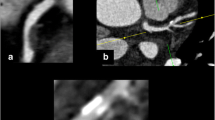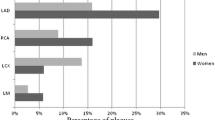Abstract
Calcium deposition along the coronary artery walls is a surrogate biomarker for atherosclerosis, and its presence in the coronary arteries could reflect the severity of coronary artery disease (CAD) High coronary artery calcium score (CACS) correlates with advanced disease and a higher likelihood of coronary stenoses. Many studies have supported the role of CACS as a screening tool for CAD. Historically, CACS was introduced with electron beam computed tomography (EBCT), but in the last 30 years, many changes have occurred in CT, where the development of multidetector spiral technology has made reliable the noninvasive study of the heart and coronary arteries. Correlation studies with intravascular ultrasound (IVUS) and histology have demonstrated the capability of multidetector CT (MDCT) to provide information useful for characterising atherosclerotic plaque in a noninvasive manner. This has shifted the interest from heavily calcified deposits to plaque with a low-density core and small, superficial calcified nodules, features more frequently present in atherosclerotic plaque prone to rupture and responsible for acute coronary events (culprit lesions). The purpose of this review article is to summarise the recent evolution and revolution in the field of CT, strengthen the importance of a coronary CT study not limited to CACS evaluation and CAD grading but also used to obtain information about plaque composition, and to improve stratification of the patient at risk for acute coronary events.
Riassunto
La deposizione di calcio lungo le pareti delle arterie coronarie è un indicatore biologico della malattia aterosclerotica e la sua quantità potrebbe riflettere la severità della malattia coronarica (CAD). Un elevato score del calcio coronarico si correla, infatti, con stadi avanzati della malattia aterosclerotica e maggiore risulta la probabilità di presenza di stenosi coronariche. In molti lavori della letteratura è stato riconosciuto al Coronary Artery Calcium Score (CACS) un ruolo di strumento di screening della malattia coronarica; storicamente esso è stato introdotto con la Electron Beam-CT (EBCT), ma negli ultimi anni la tumultuosa evoluzione/rivoluzione tecnologica in ambito della tomografia computerizzata (TC), con lo sviluppo di scanner spirali multidetettore, ha reso possibile lo studio non invasivo del cuore e delle coronarie anche con questa metodica. Studi di correlazione con l’ecografia endovascolare (IVUS) e l’istologia hanno recentemente documentato la possibilità di ottenere mediante TCMD ed in maniera non invasiva informazioni utili ai fini della caratterizzazione della placca aterosclerotica, spostando l’attenzione dai marcati depositi di calcio alle placche coronariche con core a bassa densità e piccoli noduli calcifici superficiali, reperti più frequentemente presenti nelle lesioni ateromasiche a rischio di rottura e responsabili, pertanto, di eventi coronarici acuti (culprit lesion). Lo scopo di questa review è di riassumere l’evoluzione verificatasi recentemente nel campo della tomografia computerizzata, sottolineando l’importanza di uno studio angio grafico non invasivo delle coronarie con TCMD non limitato solamente alla semplice valutazione del CACS ed al grading delle lesioni, ma utile anche al fine di ottenere informazioni relative alla composizione della placca e migliorare, quindi, la stratificazione del paziente a rischio di evento coronarico acuto.
Similar content being viewed by others
References/Bibliografia
Nieman K, Oudkerk M, Rensing BJ et al (2001) Coronary angiography with multislice computed tomography. Lancet 357:599–603
Nieman K, Cademartiri F, Lemos PA et al (2002) Reliable noninvasive coronary angiography with fast submillimeter multislice spiral computed tomography. Circulation 106:2051–2054
Ropers D, Baum U, Pohle K et al (2003) Detection of coronary artery stenoses with thin-slice multi-detector row spiral computed tomography and multiplanar reconstruction. Circulation 107:664–666
Hoffman U, Moselewski F, Cury RC et al (2004) Predictive value of 16-slice multidetector spiral computed tomography to detect significant obstructive coronary artery disease in patients at high risk for coronary artery disease. Patient-versus segment-based analysis. Circulation 110:2638–2643
Mollet NR, Cademartiri F, Nieman K et al (2004) Multislice spiral computed tomography coronary angiography in patients with stable angina pectoris. J Am Coll Cardiol 43:2265–2270
Kuettner A, Beck T, Drosch T et al (2005) Diagnostic accuracy of noninvasive coronary imaging using 16-detectors slice spiral computed tomography with 188 ms temporal resolution. J Am Coll Cardiol 45:123–127
Mollet NR, Cademartiri F, Krestin GP et al (2005) Improved diagnostic accuracy with 16-row multi-slice computed tomography coronary angiography. J Am Coll Cardiol 45:128–132
Lescka S, Alkadhi H, Plass A et al (2005) Accuracy of MSCT coronary angiography with 64-slice technology: first experience. Eur Heart J 26:1482–1487
Raff GL, Gallagher MJ, O’Neill WW, Goldstein JA (2005) Diagnostic accuracy of noninvasive coronary angiography using 64-slice spiral computed tomography. J Am Coll Cardiol 46:552–557
Mollet NR, Cademartiri F, van Mieghem CAG et al (2005) High-resolution spiral computed tomography coronary angiography in patients referred for diagnostic conventional coronary angiography. Circulation 112:2318–2323
[No authors listed] (1991) Ultrafast CT for coronary calcification. Lancet 337:1449–1450
Gould RG (1992) Principles of ultrafast computed tomography: historical aspects, mechanism of action, and scanner characteristics. In: Stanford W, Rumberger JA (eds) Ultrafast computed tomography in cardiac imaging: principles and practice. Futura Publishing, Mount Kisco, pp 1–16
Stanford W, Thompson BH, Weiss RM (1993) Coronary artery calcification: clinical significance and current methods of detection. AJR Am J Roentgenol 161:1139–1146
Moshage W, Achenbach S, Seese B et al (1995) Coronary artery stenoses: three dimensional imaging with electrocardiographically triggered, contrast agent enhanced, electron-beam CT. Radiology 196:707–714
Rumberger JA, Sheedy PF II, Breen JF et al (1996) Electron beam computed tomography and coronary artery disease: scanning for coronary artery calcification. Mayo Clin Proc 7:369–377
Achenbach S, Moshage W, Ropers D et al (1998) Value of electron-beam computed tomography for the detection of high-grade coronary artery stenoses and occlusions. N Engl J Med 339:1964–1971
Becker CR, Knez A, Jakobs TF et al (1999) Detection and quantification of coronary artery calcification with electron-beam and conventional CT. Eur Radiol 9:620–624
Agatston AS, Janowitz WR, Hidner FJ et al (1990) Quantification of coronary artery calcium using ultrafast computed tomograph. J Am Coll Cardiol 15:827–832
Wilson PW, D’Agostino RB, Levy D et al (1998) Prediction of coronary heart disease using risk factor categories. Circulation 97:1837–1847
Greenland P, Labree L, Azen SP et al (2004) Coronary artery calcium score combined with Framingham Score for risk prediction in asymptomatic individuals. JAMA 91:210–215
Becker CR, Majeed A, Crispin A et al (2005) CT measurement of coronary calcium mass: impact on global cardiac risk assessment. Eur Radiol 15:96–101
Bild DE, Bluemke DA, Burke GL et al (2002) Multi-ethnic study of atherosclerosis: objectives and designs. Am J Epidemiol 156:871–881
Cutter GR, Burke GL, Dyer AR et al (1991) Cardiovascular risk factors in young adults: the CARDIA baseline monograph. Control Clin Trials 12 [Suppl 1]:1S–77S
McCollough CH, Ulzheimer S, Haliburton SS et al (2003) A multi scanner, multi-manufacturer, international standard for the quantification of coronary calcium using cardiac CT. In: Proceedings of the 89th Scientific Assembly and Annual Meeting of the Radiological Society of North America (RSNA), Chicago, Nov 30-Dec 5, 2003. Chicago RSNA, abstract 1273, p 630
Callister TQ, Cooil B, Raya SP et al (1998) Coronary artery disease: improved reproducibility of calcium scoring with an electron beam CT volumetric method. Radiology 208:807–814
Hong C, Becker CR, Schoepf UJ et al (2002) Coronary artery calcium: absolute quantification in nonenhanced and contrastenhanced multi-detector row CT studies. Radiology 223:474–480
Hong C, Bae KT, Pilgram TK et al (2002) Coronary artery calcium measurement with multi-detector row CT: in vitro assessment of effect of radiation dose. Radiology 225:901–906
Hong C, Bae KT, Pilgram TK (2003) Coronary artery calcium: accuracy and reproducibility of measurements with multi-detector row CT — assessment of effects of different thresholds and quantification methods. Radiology 227:795–801
Hong C, Bae KT, Pilgram TK, Zhu F (2003) Coronary artery calcium quantification at multi-detector row CT: influence of heart rate and measurement methods on inter-acquisition variability. Initial experience. Radiology 228:95–100
Rumberger JA, Kaufman L (2003) A rosetta stone for coronary calcium risk stratification: agatston, volume, and mass scores in 11,490 individuals. AJR Am J Roentgenol 181:743–748
Thompson BH, Stanford W (2004) Imaging of coronary calcification by computed tomography. J Magnetic Reson Imag 19:720–733
Stanford W, Thompson BH, Burns TL et al (2004) Coronary artery calcium quantification at multi-detector row helical CT versus electron-beam CT. Radiology 230:397–402
Hong C, Pilgram TK, Zhu F, Bae KT (2004) Coronary artery calcification: effect of size of field of view on multidetector row CT measurements. Radiology 233:281–285
Ohnesorge B, Flohr T, Fischbach R et al (2002) Reproducibility of coronary calcium quantification in repeat examinations with retrospectively ECG-gated multisection CT. Eur Radiol 12:1532–1540
Morin RL, Gerber TC, McCollough CH (2003) Radiation dose in computed tomography of the heart. Circulation 107:917–922
O’Rourke RA, Brundage BH, Froelichr VF (2000) American College of Cardiology/American Heart Association expert consensus document on electron-beam computed tomography for the diagnosis and prognosis of coronary artery disease. J Am Coll Cardiol 36:326–340
O’Rourke RA, Brundage BH, Froelichr VF (2000) American College of Cardiology/American Heart Association expert consensus document on electron-beam computed tomography for the diagnosis and prognosis of coronary artery disease. Circulation 102:126–140
Sones FM Jr (1959) Acquired heart disease: symposium on present and future of cineangiocardiography. Am J Cardiol 3:710
Sones FM (1962) Cine coronary angiography. Mod Concepts Cardiovasc Dis 31:735–738
Topol EJ, Nissen SE (1995) Our preoccupation with coronary luminology. The dissociation between clinical and angiographic findings in ischemic heart disease. Circulation 92:2333–2342
Falk E, Shah PK, Fuster V (1995) Coronary plaque disruption. Circulation 92:657–671
Naghavi M, Willerson JT (2003) From vulnerable plaque to vulnerable patient. A call for new definitions and risk assessment strategies: Part I. Circulation 108:1664–1672
Kennedy JW (1982) Complications associated with cardiac catheterization and angiography. Cath Cardiovasc Diagn 8:5–11
Davidson CJ, Fishman RF, Bonow RO (1997) Cardiac catheterization. In: Braunwald E (ed) Heart Disease: a textbook of cardiovascular medicine. WB Saunders, Philadelphia, pp 177–203
Achenbach S, Moselewski F, Ropers D et al (2004) Detection of calcified and noncalcified coronary atherosclerotic plaque by contrast-enhanced, submillimeter multidetector spiral computed tomography. A segment-based comparison with intravascular ultrasound. Circulation 109:14–17
Leber AW, Knez A, Becker A et al (2004) Accuracy of multidetector spiral computed tomography in identifying and differentiating the composition of coronary atherosclerotic plaques. A comparative study with intracoronary ultrasound. J Am Coll Cardiol 43:1241–1247
Ehara S, Kobayashi Y, Yoshiyama M et al (2004) Spotty calcification typifies the culprit plaque in patients with acute myocardial infarction. An intravascular ultrasound study. Circulation 110:3424–3429
Glagov S, Weisenberg E, Zarins CK et al (1987) Compensatory enlargement of human atherosclerotic coronary arteries. N Engl J Med 316:1371–1375
Schoenhagen P, Ziada KM, Kapadia SR et al (2000) Extent and direction of arterial remodeling in stable versus unstable coronary syndromes. An intravascular ultrasound study. Circulation 101:598–603
Flohr TG, Stierstorfer K, Ulzheimer S et al (2005) Image reconstruction and image quality evaluation for a 64-sliceCT scanner with Z-flying focal spot. Med Phys 32:2536–2547
Nikolaou K, Becker CR, Muders M et al (2004) Multidetector-row computed tomography and magnetic resonance imaging of atherosclerotic lesions in human ex vivo coronary arteries. Atherosclerosis 174:243–252
Schroeder S, Kopp AF, Baumbach A et al (2001) Noninvasive detection and evaluation of atherosclerotic coronary plaques with multislice computed tomography. J Am Coll Cardiol 37:1430–1435
Schroeder S, Kuettner A, Leitritz M et al (2004) Reliability of differentiating human coronary plaque morphology using contrast-enhanced multislice spiral computed tomography. A comparison with histology. J Comput Assist Tomogr 28:449–454
Author information
Authors and Affiliations
Corresponding author
Rights and permissions
About this article
Cite this article
Marano, R., Bonomo, L. Coronary artery calcium score: has anything changed?. Radiol med 112, 949–958 (2007). https://doi.org/10.1007/s11547-007-0195-8
Received:
Accepted:
Published:
Issue Date:
DOI: https://doi.org/10.1007/s11547-007-0195-8
Key words
- Coronary artery calcium score
- Coronary calcium screening
- Multidetector computed tomography
- Intravascular ultrasound




